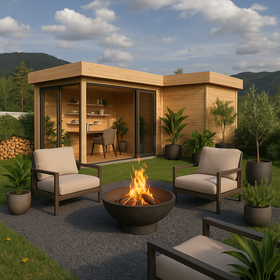512-777-0154

How Big Is A Music Room? Ideal Dimensions, Ratios, and Floor Plans for Any Space
A music room doesn’t need to be huge. Most work beautifully at 100–400 sq ft. But how big is a music room really? The fun part is tailoring it to your instrument, acoustics, and creativity.
The room you choose will shape the way your music feels and how well you can control the sound. Some rooms help you play better. Others work against you from the moment you press a key.
This guide breaks down the dimensions, ratios, and layouts that help a room behave. Whether you’re building a home practice space or a studio for serious work, you’ll find the numbers and ideas that make everything click.
The Quick Answer: Standard Music Room Size and Dimensions
Before getting into ratios and acoustic math, here’s the simple answer most people need. A typical music room is around 215 sq ft (20 sq m). That’s large enough for instruments, acoustic treatment, and comfortable movement without creating major sound problems.
Some people work with more space. Some squeeze into less. But this range tends to hit the sweet spot for everyday use.
Standard Size in Square Footage and Square Meters

Let’s break down the direct answers people search for most. These include:
- How big is a music room in meters?
- Music room standard size in feet?
- How big is a music room in feet?
Most music rooms average 215 sq ft or 20 sq m. This size gives you enough room for treatment, a desk, a few instruments, and a layout that avoids the tight “boxy” feeling small rooms create. It’s a comfortable baseline for beginners and seasoned musicians.
Common Dimensions (Feet and Meters)
Now let’s talk about actual measurements instead of square footage. Many well-balanced rooms fall near:
- 15 ft x 16 ft
- 4.5 m x 5 m
A rectangular shape matters more than people expect. Square rooms create duplicated resonances that stack up and cause uneven bass. A rectangle spreads these issues out, giving you more control and less frustration.
The Professional Answer: Recording Studio Dimensions and Acoustics
Once you move beyond general practice rooms, dimensions start to matter a lot more. Recording studios need specific shapes, volumes, and ratios to avoid unpredictable acoustics. This is where science steps in and helps you avoid costly mistakes.
Why Acoustics Demand Specific Dimensions (Room Modes and Volume)

Every room has “room modes.” These are frequencies that bounce between walls and either get louder or disappear. When a room is too small or shaped poorly, these modes build up and cause boomy bass, quiet notes, or strange dips in the sound.
Room volume (ft³ or m³) is a big player here. More volume gives sound waves space to spread out. Less volume forces them to collide and create problems.
Small rooms aren’t impossible, but they usually need heavier treatment and more planning.
The Golden Ratios: Ideal Room Proportions for Critical Listening
Acousticians have suggested ratios for decades: ratios that help sound behave more evenly. Some of the most respected include:
- 1 : 1.6 : 2.6 (Golden Mean)
-
Sepmeyer Ratios:
- 1 : 1.14 : 1.39
- 1 : 1.28 : 1.54
- 1 : 1.60 : 2.33
These aren’t magic numbers. They simply help distribute acoustic pressure so no single frequency dominates the room. When dimensions line up well, your bass becomes clearer, and your speakers tell the truth.
Minimum Recommended Control Room Dimensions
If you’re aiming for a true control room (one meant for mixing or mastering), you’ll want something larger than the typical music room. A dependable example used by many acousticians is:
- 17.5 ft × 23 ft × 10 ft
- (5.3 m × 7 m × 3 m)
Rooms near this size allow accurate monitoring without forcing you to fight the low end constantly. They’re easier to treat and offer more predictable results.
Optimizing the Space: Music Room Floor Plan and Layout
Once you know the size, the next step is figuring out how to use it. A room that’s arranged poorly will always feel “off,” even if the dimensions are great.
Floor Plan Considerations for Different Instruments

Different instruments take up different amounts of room. A drum set needs a large footprint and plenty of breathing room for microphones. A grand piano comes with a lid that changes how sound bounces. A rehearsal setup needs space for players and gear.
Here’s a quick guide:
- Drums: 50–70 sq ft
- Grand piano: 70–100 sq ft
- Band rehearsal: 150–250 sq ft
The more sound an instrument produces, the more space it needs to settle and breathe.
The 38% Rule: Positioning Your Desk and Listening Spot
For rooms used for mixing or digital instruments, this rule is incredibly helpful. Sit about 38% of the way back from the front wall. Not in the center. Not against the wall.
This position avoids the strongest bass nulls and gives you the most even response from your speakers. Even in a small room, this one change tightens up the low end immediately.
Layout Tips for Multi-Function Rooms (Listening vs. Practice)
Many music rooms aren’t just one thing. They’re part practice room, part studio, and part relaxing hangout. A flexible layout keeps the room from feeling cramped or cluttered.
Try:
- Keeping your desk centered
- Storing gear along the back or side walls
- Using movable acoustic panels
- Leaving open space for playing or recording
This kind of layout makes the room work for every activity without constant rearranging.
Essential Tools for Planning: The Room Dimension Calculators
You don’t have to guess whether your room dimensions are workable. There are simple tools that give quick feedback and help you avoid problematic designs before buying a single panel.
Understanding a Room Ratio Calculator

A room ratio calculator compares your dimensions with known acoustic ratios. It usually gives results like:
- Good
- Fair
- Needs Work
This is an easy way to check if your room will fight you or help you. It’s especially useful before you change anything or start treating the space.
Using a Reverberation Time (RT60) Calculator
RT60 measures how long a sound takes to fade by 60 dB. In a studio, shorter decay is better. You want an RT60 between 0.3 and 0.5 seconds.
Longer decay times make mixes muddy. They also make playing feel less controlled, especially on drums or piano.
The Critical Role of Ceiling Height
Ceiling height is often overlooked, but it affects everything. An ideal height for a music room is 9 ft (2.7 m) or more.
Lower ceilings create early reflections and bass buildup. You can treat them, but the job becomes much harder. A little extra height saves a lot of trouble.
Defining “Big Room”: A Different Kind of Music
Since so many people search for “big room,” it’s worth mentioning that it's actually a music genre, not a room size. This helps clear up the mix-up and gives readers what they came looking for.
Big Room Music: The Genre Defined

Big Room is a loud, festival-ready style of EDM. It’s built around simple melodies, long builds, and huge drops. The goal is to make thousands of people jump at once.
It became popular at massive festivals where the sound needs to carry across wide outdoor spaces.
Key Characteristics and Popular Artists
The style is known for:
- Punchy beats
- Anthem-like leads
- Minimal but powerful arrangements
Artists often associated with Big Room include Martin Garrix, Hardwell, and Dimitri Vegas & Like Mike.
Prioritizing Proportions Over Pure Size
A great music room isn’t about having the biggest space; it’s about getting the proportions right. When your room has a balanced shape, a comfortable ceiling height, and a layout that supports how you work, everything from the bass to the feel of the room improves.
With thoughtful planning and the right dimensions, any space can become a place where music sounds natural, plays well, and inspires you every time you step inside.



